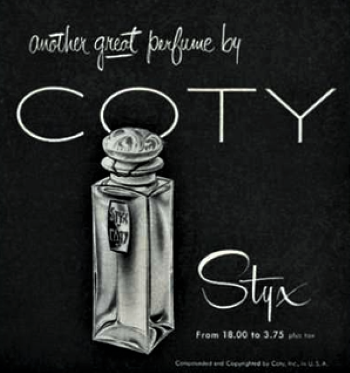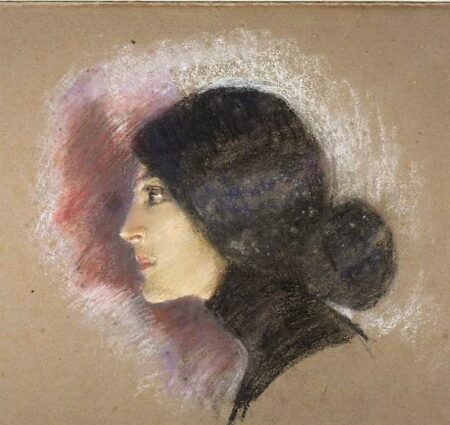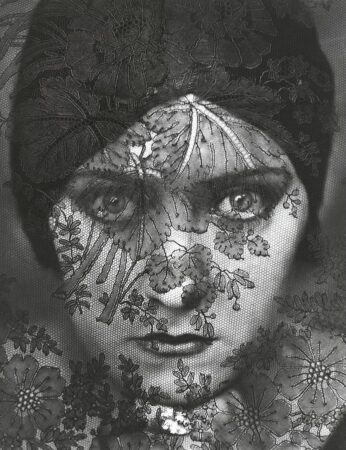
Coty Styx, photo by Lauryn©
“Dark, mysterious and pagan” was Styx’s tagline when it released. Launched in 1911 or 1912 midway between Francois Coty’s first fragrance, 1904’s La Rose Jacqueminot, and 1917’s Chypre, Coty Styx treads a center ground between classical and modern in more ways than one. Its name initially seems a strange choice for a fragrance of the time. The mythological river that separated the living and the dead? Really, Francois? Even given the au courant interest in neoclassicism back in Styx’s day, the choice of something so closely associated with darkness and death seems an odd one. But ever the prescient marketer, Coty must have understood that provocation sells (hello, Yves St. Laurent Opium), and that there was a legion of women out there craving something a bit naughtier than a pretty, well-bred soliflore. Enter Coty Styx.

Francois Coty courtesy of Francoiscoty.fr
In 1911, Mary Pickford was the world’s first female movie star, the epitome of plucky wholesomeness. But, of course, not every woman who sat in those dark, flickering movie houses fantasized about being saved. After all, the female counterpoint to all that sweetness and light – the vamp – was enjoying immense popularity in art and literature in the early 1900s, making way for cinema’s first vamp in Helen Gardner’s Cleopatra in 1912. By choosing the name of the mythological river that separated the living from the dead, Coty grasped that there were plenty of women who fantasized about being bad girls as they sat transfixed in the darkness of the movie house, imagining themselves enslaving hapless men rather than getting themselves untied from railroad tracks. So, Styx, a name that conjured a dark river of whose inky waters could confer immortality, was on the money. Indeed, it remained popular enough to stick around for 50 years and was even revived for a spell in the 70s. Meanwhile, the canny Coty proved his knack for understanding the public appetite for fragrance by becoming the richest man in France by the end of WWI.

I’ve read widely different descriptions this enigmatic fragrance, ranging from green and mossy, powdery and floral, to ambery and incense laden or classic chypre. I cannot find an original list of notes, though two websites state them as follows: Top notes: bergamot, carnation, ylang, galbanum; Heart notes: orris, incense, violet; Base notes: amber, patchouli, sandalwood, vanilla, benzoin, woods, musk and oakmoss. If these notes are indeed correct, the chypre construction is evident, but so, too, is an amber-vanilla-incense blueprint for something that anticipates the style Shalimar or Coty’s own Emeraude in 1921, with whom Styx shares noticeable DNA, and leads it in a more modern direction in the perfume’s later stages.

Vamp of 1900 (Lottie Stein) by Alice Pike Barney, Smithsonian
To my nose, Coty Styx is a deeply musky – though not animalic – ambery floral, shadowy, somber, and quite elegant. There is a hefty helping of orris and carnation in here – the powdery, sang-froid heart gives that away – as well as ylang (who could mistake that lush floral note?) for a touch of sensuality. Sandalwood, amber and vanilla make up the dense base, though coming back to Styx a few minutes later, I get also a whiff of bitter oakmoss.
But to me, the real stars of this fragrance are the orris and musk. Styx has an aloof coolness in its first that is dominated by powdery orris and, a bit later, woody violet. The incense for me is there, but alas, quite muted, possibly because my bottle is EDT. I would love to smell this in extrait form to see if it is more obvious. Styx’s second act though, is where its kinship with sister-to-be Emeraude comes through. Sweet, furry musk combines with amber, candied vanilla and sandalwood. These notes take the perfume in a different direction than its floral beginnings. The fragrance goes darker, deeper and sexier, but never loses its manners. There’s a touch of dried milk here, a puff of smoke, and the carnation nudges through again towards dry-down.

Gloria Swanson by Edward Steichen
Styx is not an obvious vamp like those post-WWII pinups Rochas Femme and Piguet Fracas. She’s a more subtle creature, less come-hither stare than suggestively raised eyebrow, more Gloria Swanson than Theda Bara: dark-haired, pale-skinned, aristocratic. Whoever she is, I am fascinated by her.
Bottle of Coty Styx from my own collection.
Lauryn Beer, Senior Editor
Editor’s Note: In search for authentic vintage Coty? Check out Fragrance Vault who carries a selection
According to Creative Director, blogger and author Barbara Herman, Coty Styx was launched in 2011
Follow us on Instagram: @cafleruebonofficial@elledebee,@francois_coty @vcoty
